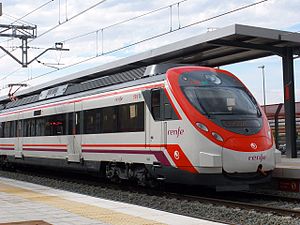| Civia 462, 463, 464 and 465 | |
|---|---|
 Civia 463 EMU at Utebo operating under Cercanías Zaragoza. | |
 The interior of a Civia train of Cercanías Cádiz. | |
| In service | 2003–present |
| Manufacturer | CAF, Siemens and Alstom |
| Constructed | 2002–2003, 2004–2010 |
| Entered service | 2003 |
| Formation |
|
| Capacity |
|
| Operators | Renfe (2003–2005, 2007–present) |
| Specifications | |
| Car length |
|
| Width | 2,940 mm (9 ft 7.75 in) |
| Height | 4,265 mm (13 ft 11.91 in) |
| Doors | 4 per car |
| Maximum speed | 120 km/h (75 mph) |
| Weight |
|
| Power output |
|
| Electric system(s) | 3 kV DC (nominal) from overhead catenary |
| Current collector(s) | Pantograph |
| Safety system(s) | ASFA, ASFA Digital, ERTMS |
| Track gauge | 1,668 mm (5 ft 5+21⁄32 in) Iberian gauge |
Civia is a class of electric multiple unit trains built by CAF, Siemens and Alstom for the Renfe Cercanías commuter railway networks in Spain. The first units entered service in 2003.
The Civia train concept was created with passenger comfort and build quality in mind, and to meet the goals of reliability, frequency and punctuality. They have better provision for disabled passengers than older Cercanías trains.
Technical details[edit]
Civia units use 3kV DC overhead electrification. The maximum speed of Civia units in service is 120 km/h (75 mph), but with modifications they will be able to reach 160 km/h (99 mph).
Modularity[edit]
Civia are modular units - trains can be formed from two, three, four or five cars as required.[1] There are four car types:
- A1 - end car with driving cab and normal floor.
- A2 - end car with driving cab and normal floor.
- A3 - intermediate car and downstairs WC.
- A4 - intermediate car with normal floor.
Cities and routes[edit]
Civia units operate in the following cities and regions:
Accident[edit]
On 28 July 2017, Class 465 unit 210M collided with a buffer stop at Barcelona França station, causing 54 injuries of which 5 were serious.[2]
Gallery[edit]
-
A rare Civia 462 near Padre Pío-Palmete, Seville
-
Civia 465 on its original livery in Chamartín station, Madrid
-
Civia 463 in El Entrego, Asturias
-
A Civia 465 with the Rodalies de Catalunya livery at Barcelona Estació de França
-
Coupled Civias 465 and 463 at Granollers Centre, Barcelona
-
A Civia 463 in Málaga Airport
-
A Civia 465 in Silla, Valencia
-
A Civia 465+463 near Mollet - Sant Fost train station (Catalonia).
Scheme[edit]

See also[edit]
References[edit]
- ^ CAF - Civia (Spanish)
- ^ Perring, Rebecca (28 July 2017). "BREAKING: Barcelona train crash - scores injured as rush-hour service ploughs into station". Express.co.uk. Retrieved 28 July 2017.
External links[edit]
- Renfe - Our Trains
- Ferropedia - Renfe Civia Archived 2020-02-10 at the Wayback Machine (Spanish)











